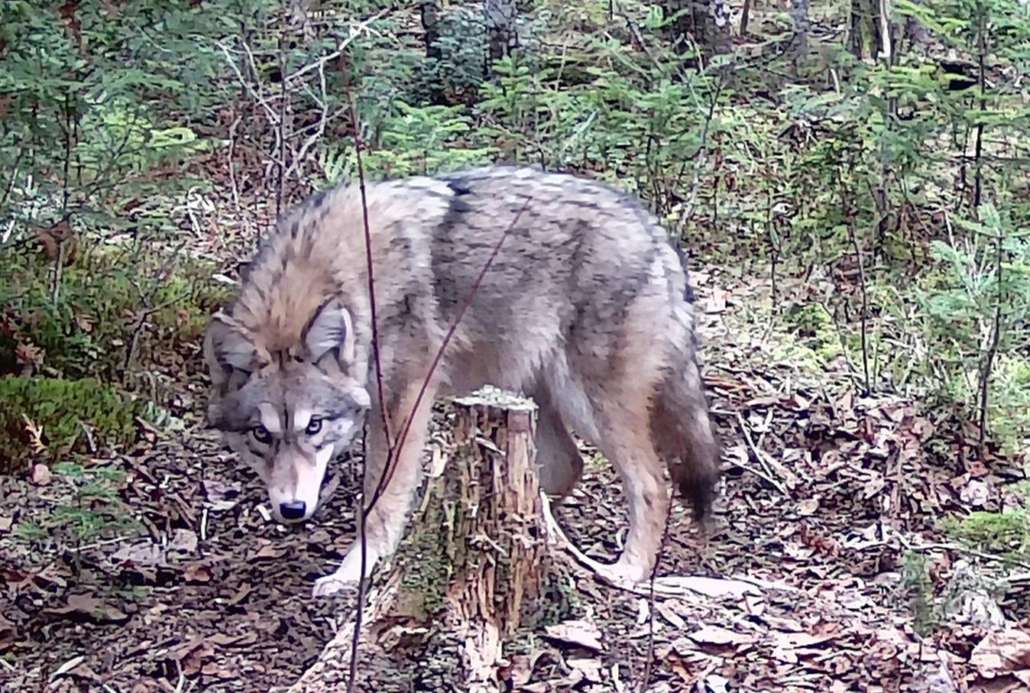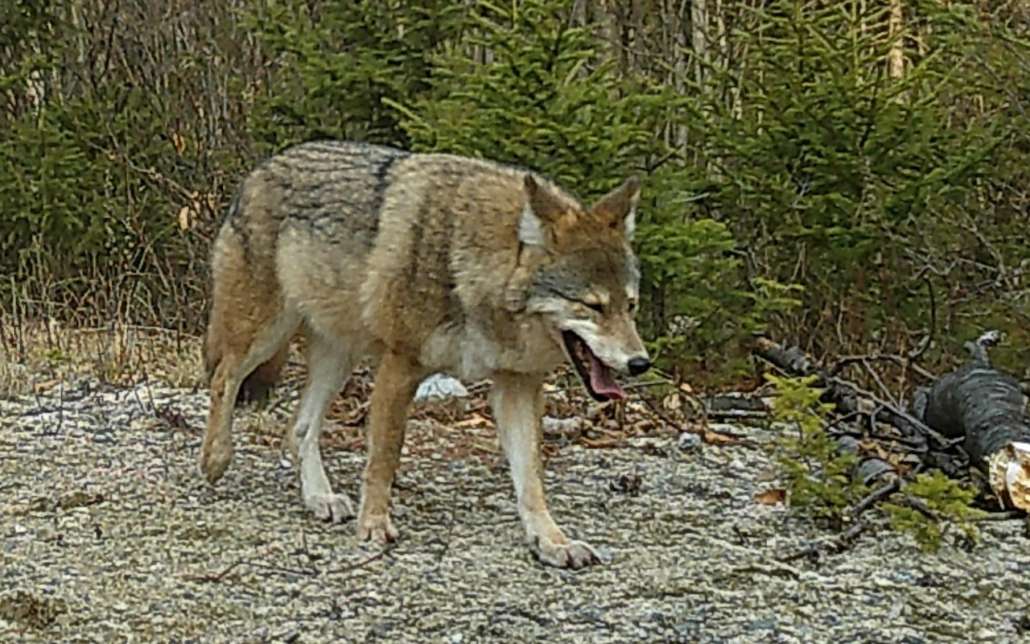SCORES & OUTDOORS – So many wolf questions: here are some answers
 by Roland D. Hallee
by Roland D. Hallee
With the increasing number of wolf sightings reported to me, I found it necessary to revisit the subject. Thanks to John Glowa, of the Maine Wolf Coalition, I will share with you the contents of an email he submitted to The Town Line.
Wolves are attempting to recolonize the northeast after a century’s absence. The closest acknowledged wolf populations are in Québec, just 60 miles from New York and 75 miles from Maine. Thousands more wolves live in southern and central Canada and the Great Lakes states, well within the 1,000+ mile distance that wolves have been known to travel during dispersal.
Dispersal is simply a young wolf leaving its pack’s territory in search of a mate and a territory of its own. These dispersing young wolves are often called “lone” wolves. Just as we humans do, nearly all young wolves leave home to live and possibly raise a family of their own.
Wolves are an essential part of a healthy ecosystem. In the northeast, the lack of wolves after we exterminated them in the 19th century allowed coyote/wolf hybrids to move in from Canada where coyotes and wolves interbred. The offspring of these hybrid animals crossed the St. Lawrence River more than a century ago and their populations grew. Their range expanded because they had no competition from wolves for food and territory. They now live throughout the northeast and maritime Canada including Prince Edward Island and Newfoundland. These coyote/wolf hybrids are believed to have established a population in Maine by the 1930s and now number in the thousands in Maine alone.
It is important to know that there are no coyotes in the northeast U.S. All large canids are either coyote/wolf hybrids or wolves. The northeast canid referred to as a coyote or eastern coyote is not a species but is a coyote/wolf hybrid.
In 1993, a young female wolf was killed by a bear hunter in northern Maine. Since then, a dozen or so wolves have been documented killed by hunters or trappers south of the St. Lawrence River. Most of these were large animals that were primarily gray wolf. It is believed that Maine once had both gray wolves and eastern wolves. Gray wolves are larger animals – the animals that we normally think of as wolves. They generally range from 65-90+ pounds and prey primarily on moose, deer and beaver. Eastern wolves are smaller and generally range from 45-65 pounds. They seldom prey on moose, but do prey on deer, beaver and smaller animals. They will also eat berries, and their diet is similar to that of coyote/wolf hybrids. These animals can easily be confused with “coyotes” and it is likely that some of Maine’s eastern wolves are killed by hunters and trappers but are unreported due to their smaller size. Eastern wolves are now considered a threatened species in Canada. The U.S. government does not recognize the eastern wolf as a species, but rather as a gray wolf. This position is being reviewed and is subject to change. In 2019, the Maine Wolf Coalition collected a scat in northern Maine that was documented through DNA analysis to have come from an eastern wolf.
Wolves in Maine continue to be protected by federal law, but that law is not enforced. It is impossible to tell the difference between a “coyote” and an eastern wolf just by sight. The State of Maine encourages the killing of wolves by encouraging the killing of “coyotes”. The State of Maine wants nothing to do with wolves and excludes them from its State Wildlife Action Plan (SWAP). SWAPs are revised every ten years, and the 2025 SWAP is presently being written by various state agencies in order to qualify for federal funding for the state.
On a federal level, the U.S. Fish and Wildlife Service (Service) has tried and failed for years to have wolves removed from the list of endangered species. Multiple losses in court have resulted in a recent proposal by the Service to develop a National Gray Wolf Recovery Plan. That plan is supposed to be rolled out by late 2025. Wolf advocates including the Maine Wolf Coalition (MWC) recently met with representatives of the service to urge the agency to include the northeast in the recovery plan and to offer our assistance in developing it. Our more than 30 years of wolf advocacy have accumulated a wealth of information about the status of wolves and the potential for wolf recovery in the northeast and Canada south of the St. Lawrence River.
A major recent development has been the establishment of the Northeast Wolf Recovery Alliance (NEWRA) in 2023. MWC is a charter member of NEWRA which includes as members individuals and organizations from New York, Rhode Island, Massachusetts, Vermont, New Hampshire, Maine, Ontario and Québec as well as two national wildlife advocacy organizations. We have come to realize that it is essential for the U.S. and Canada to work together for wolf recovery in the region because wolves do not recognize invisible national boundaries.
Since 2019, MWC has actively been collecting canid scat across Maine for DNA analysis. This is work that neither the state of Maine nor the service is doing. We presently have nearly 200 scats at Michigan Technological University awaiting analysis. We have also been collecting some amazing trail camera photos and videos of wolflike canids from the Maine-New Hampshire border to far northern Aroostook County. We hope to document the status of wolves in Maine to try to force the state and federal governments to actively work to protect and recover them.
We have believed and we continue to believe that wolf recovery in the northeast will happen if we simply let it happen. Wolves in Canada and the northeast need real protection from hunters and trappers. We have never advocated reintroducing or bringing wolves into the northeast and releasing them. The evidence tells us that wolves are already here and that they will recover…if we only let them.
Roland’s trivia question of the week:
What country has competed the most times in the Summer Olympics, yet hasn’t won a gold medal?
Responsible journalism is hard work!
It is also expensive!
If you enjoy reading The Town Line and the good news we bring you each week, would you consider a donation to help us continue the work we’re doing?
The Town Line is a 501(c)(3) nonprofit private foundation, and all donations are tax deductible under the Internal Revenue Service code.
To help, please visit our online donation page or mail a check payable to The Town Line, PO Box 89, South China, ME 04358. Your contribution is appreciated!




John Glowa is just another wackadoo that hates trappers and hunters. His failed run for Governor should tell people all they need to know about him…I say stop giving him a platform in which to spew his propaganda…..with him, it’s gotta be his way or nothing. He is not willing to work along side of anyone with so much as an opposing opinion